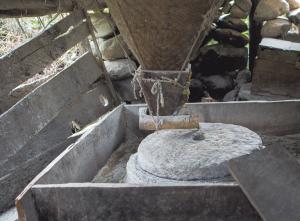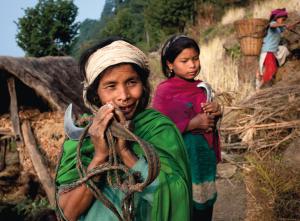70% of Nepal’s rural population lack grid access
Marilyn Smith is Executive Director of EnAct.
For centuries, people in rural Nepal have relied on the kinetic energy of running water for arduous manual tasks such as grinding grain.

With a few basic tweaks to traditional water mills, the Centre for Rural Technology (CRT) has stimulated economic development and contributed to gender and social equality.
Mountainous Nepal has almost thirty thousand miles of rivulets, streams, and rivers, an abundant source of renewable energy. Yet this challenging terrain contributes to high levels of energy poverty: about seventy percent of the rural population lacks grid access.
Up close, the beauty of Nepal's terraced hillsides quickly becomes a vision of hardship. Snaking among plots of corn, wheat or rice are narrow paths, hardened over centuries by bare-foot women carrying fifty-pound sacks to the local water mill for grinding. In recent decades, some mills installed diesel generators and traditional wood turbines powered by water diverted from local streams could no longer compete. Faced with the prospect of longer walks and higher costs, many women returned to using hand-power grinders at home, but had a harder time getting a quality product to the markets. In the 1980s, the CRT, together with government agencies and international development partners, set out to re-boot rural economies by making abandoned mills more efficient. The simple solution of a metal turbine, designed with wide blades that would better capture water, proved to be a game-changer.
With a typical shaft revolution per minute (RPM) of 120 to 160, traditional water mills (TWMs) generated a power output of 0.2 kilowatts (kW) to 0.5 kW, delivering a grinding capacity of twenty to fifty pounds of grain per hour. But water and wear meant replacing the turbine's wooden pegs every two years or so.
 Nepalese women shoulder most of the burden associated with agricultural and household tasks. Photo: S. Kharel / Nepal
Nepalese women shoulder most of the burden associated with agricultural and household tasks. Photo: S. Kharel / Nepal
By contrast, the improved water mill (IWM) reaches 200 to 300 rpm, generating 0.5 kW to 3 kW. In turn, grinding capacity doubled from fifty to one hundred pounds per hour and the metal turbines show an average lifespan of around ten years. Additionally, while TWMs often ground to a halt in the dry seasons, IWMs operate efficiently even with low water levels.
Everyone wins with faster milling times and year-round service. Customers have shorter waits and lower costs, while many who own and operate IWMs have been able to double their incomes. Some are adapting IWMs to other purposes, adding a belt drive, for example, to support rice-husking, oil extraction, spice grinding, crushing sugar cane and even saw milling.
For many, the ultimate goal is electricity, and the 3 kW of the IWMs have proven sufficient for lighting, operating small electric and electronic devices (TVs, radios and even computers), and doing a side business in battery charging.
With more than seven thousand IWMs installed so far, the CRT estimates the following impacts:
- Reduced workload, particularly for women and girls, for agro-processing services of about three hundred and eight-four thousand households.
- Diversified agro-processing services for fifty-seven thousand rural households.
- Market development and local capacity building, as fifty percent of owners/millers have organized into groups and associations.
- Social development, as twenty-five percent of IWM owners are women and members of marginalized communities, their status is improving.
The project partners confirm that tremendous opportunity still exists: more than twenty thousand additional TWMs are ripe for restoration. Centre for Rural Technology, Nepal: http://crtnepal.org/
For more information on EnAct or how to support it, visit the websites http://www.en-act.org and http://www.coldathome.today, or contact our Executive Director at marilyn.smith@en-act.org



